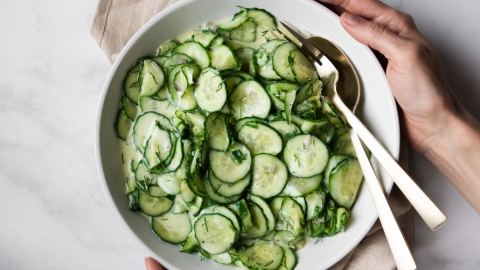Cool as a Cucumber
Many gardeners find themselves swimming in zucchini this time of year, but in my case, it’s always cucumbers. Each year, I resolve to grow only one plant, reasoning it could hardly produce the colossi of previous summers—I am continually proven wrong! Naturally, one family can only consume so much of this cucumiform before the rest are given to friends and neighbours (whether they like it or not!).
Cucumbers (Cucumis Sativus) are fruiting vine plants in the cucurbitaceae or gourd family which have been cultivated for over 3000 years. Original cultivars were grown in South Asia and India before making their way across the globe and onto unsuspecting neighbours’ doorsteps. These vigorous growers are commonly treated as vegetables in the culinary world; however, cucumbers are technically non-sweet fruits like squash and tomatoes. With charming names like Corinto, Piccolino, Poniente and beneficial nutrients like fiber, vitamin K and antioxidants, there is a lot to love about this plentiful summer food.
Presently, there are over 130 cucumber varieties grown and consumed worldwide, all of which can be lumped into one of three categories: slicing, seedless or pickling. Slicing (or slicers) are typically grown for raw consumption, but their skin and seeds are usually removed. The typical slicer, with its thick dark skin and large seeds, differs from the thinner-skinned seedless (or burpless) cucumber, which has a sweeter taste and smaller palatable seeds. Seedless varieties are often grown in hothouses and tend to be shrink-wrapped to protect their delicate skin on the way to the produce shelf. Pickling cucumbers speak for themselves; these varieties were bred specifically for their thin yet firm skins and small uniform size, which makes them ideal for submerging in brine.
The most popular variety consumed in North America is the seedless English, Persian or European cucumber, and with reason: their mellow flavour and attractive thin skin makes these cucumbers pleasant to eat and easy to use in recipes (no peeling or seeding necessary). Taste and texture aside, one could also reason these are the most popular because they are the most widely available, and this is certainly true. However, a visit to a local market or grower could open your eyes to a plethora of delicious and eye-catching choices like Striped Armenians, Lemon Cukes or Crystal Apple cucumbers—these and other unique varieties grow in popularity every year.
With a high water content and mild taste, cucumbers are quite a versatile food. They can take on any number of flavours depending on how they are prepared and with which ingredients they mingle. While most consider cucumbers destined for veggie platters, sandwiches or salads, they can actually be used in a variety of ways—cold soups, salsas, juices, pickles, water infusions and beauty applications, or in classics like Greek salad, tzatziki or raita. Moreover, cooked cucumbers, while often overlooked in North America, have long been consumed in Asian cuisine as side dishes or in stir-fries where they add crisp texture and delicate flavour to a dish.
Nevertheless, as versatile as cucumbers can be, recipes that capture their cool and refreshing qualities are my preference this time of year. German cucumber salad, or gurkensalat, is a beloved dish from my childhood and is extraordinarily simple to prepare. Made of paper thin cucumber slices and a creamy, tangy sauce, gurkensalat can be served with a number of main dishes (roasted poultry, grilled meat, salmon etc.) or enjoyed on its own straight from the fridge. This modest recipe always reminds me of simpler times when my biggest worry was whether there was enough gurkensalat left over for the next day.






